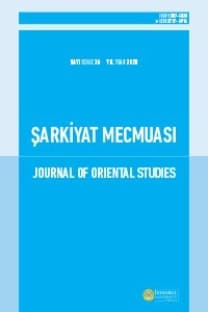SEMİYOLOJİ IŞIĞINDA, MUHYİDDİN İBN ARABİ’NİN YORUMLARI VE YORUMLARININ SINIRLARI*
Bu araştırma Muhyiddin İbn Arabi’nin yorumlarını ve yorumlarının sınırlarını semiyotik açıdan değerlendirmeyi amaçlamıştır. Araştırmada yapısal açıdan, İbn Arabi’nin görüşlerindeki semiyotik (göstergebilimsel) olguların incelenmesine ışık tutan kapsamlı bir metodolojinin izlenmesi ön görülmüştür. İşbu tezde Akberi sofi ekolunun (Söyleyiş, anlam ve bilim) üçlemi ve Semiyotik ekolunun (gösteren, gösterilen ve yorumlayıcı) üçlemleri arasındaki farklılıklar ve benzerlikler anlamsal açıdan incelenerek Sofi Akbari’nin (Muhyiddin İbn Arab) birçok yorumlayıcı görüşlerinde semiyotik (göstergebilimsel) ekolüyle benzerlik olduğunu savunurken diğer taraftan da bu iki ekol arasındaki bağdaştırıcı köprüler kurmaya çalışılmıştır. Ayrıca bu iki ekol arasındaki kabul edilir (makul) ve yanlış meallere etken olabilecek olgu ve kavramların sınırlarını belirleyerek incelemiştir.
Anahtar Kelimeler:
İbn Arabi, Semiyotik, Yorumlama.
THE PRINCIPLES OF MUHYIDDIN IBN ARABI’S INTERPRETATION AND ITS LIMITS IN THE LIGHT OF SEMIOLOGY
This study aimed to make a semiotic comparison of the principles of Muhyiddin Ibn Arabi’s interpretation and its limits. The nature of the paper necessitated employing a methodology that was based on comparison that surveyed the semiotic similarities for Ibn Arabi’s interpretational views. The paper was based on a hypotheses claimed that the semiotic interpretation agrees with the Akbar sophist interpretation in many interpretational views. This paper also sought to present an attempt of a comprehensive vision for the interpretational views of these two approaches. Also, the paper tried to bridge the gap between the Gnostic sophistic interpretation and the methodological semiotic one by means of studying the semantic structure for Ibn Arabi that was represented in the triangle: utterance, understanding and knowing and comparing it with the semantic semiotic triangle which was represented by sign, signifier and signified. Moreover, the paper studied the limits of interpretation that were represented in multi-understandings, meanings and conditions that separate the acceptable interpretation from the incorrect interpretation for the two interpretational approaches. approaches. Also, the paper tried to bridge the gap between the Gnostic sophistic interpretation and the methodological semiotic one by means of studying the semantic structure for Ibn Arabi that was represented in the triangle: utterance, understanding and knowing and comparing it with the semantic semiotic triangle which was represented by sign, signifier and signified. Moreover, the paper studied the limits of interpretation that were represented in multi-understandings, meanings and conditions that separate the acceptable interpretation from the incorrect interpretation for the two interpretational approaches.
___
- 1- E.D.Hirsch,Jr, The Validity Of Interpretation, Yale University Press, 1967.
- 2- Frege, Gottlob, "The Thought: A Logical Inquiry" , trans- into English by Anthony Quinton, Mind. C. 65, No. 259, 1956. sa. 289-311.
- 3- Hans-Georg Gadamer, GadamerIn Conversation, Ed: Richard E. Palmer, Yale university press, New Haven &London, 2001.
- 4- Ian Almond, "The honesty of the perplexed: Derrida and Ibn 'Arabi on 'bewilderment'", Journal of the American Academy of Religion, ,C. 70, No 3, September 2002 s. 515-537.
- E. D. Hirsch, Jr, The Validity Of Interpretation, Yale University Press, 1967.
- Frege, Gottlob, “The Thought: A Logical Inquiry” , trans- into English by Anthony Quinton, Mind. C. 65, No. 259, 1956. sa. 289-311.
- Hans-Georg Gadamer, GadamerIn Conversation, Ed: Richard E. Palmer, Yale university press, New Haven &London, 2001.
- Ian Almond, “The honesty of the perplexed: Derrida and Ibn ‘Arabi on ‘bewilderment’”, Journal of the American Academy of Religion, ,C. 70, No 3, September 2002 s. 515-537.
- ISSN: 1307-5020
- Yayın Aralığı: Yılda 2 Sayı
- Başlangıç: 1956
- Yayıncı: İstanbul Üniversitesi Edebiyat Fakültesi Şarkiyat Araştırma Merkezi
Sayıdaki Diğer Makaleler
SEMİYOLOJİ IŞIĞINDA, MUHYİDDİN İBN ARABİ’NİN YORUMLARI VE YORUMLARININ SINIRLARI*
Malek Hassan Mahmoud ABDULQADER, İbrahim ŞABAN
19. YÜZYILDA URDUCA VE HİNTÇE ROMANLARDA HİNDİSTAN TOPLUMU
KARANLIĞA VE GECEYE TAKINTILI BİR ŞAİR: FURÛĞ FERRUHZÂD
CAFER MÜDERRİS SÂDIKÎ’NİN GAVHÛNÎ ROMANININ TAHLİLİ
